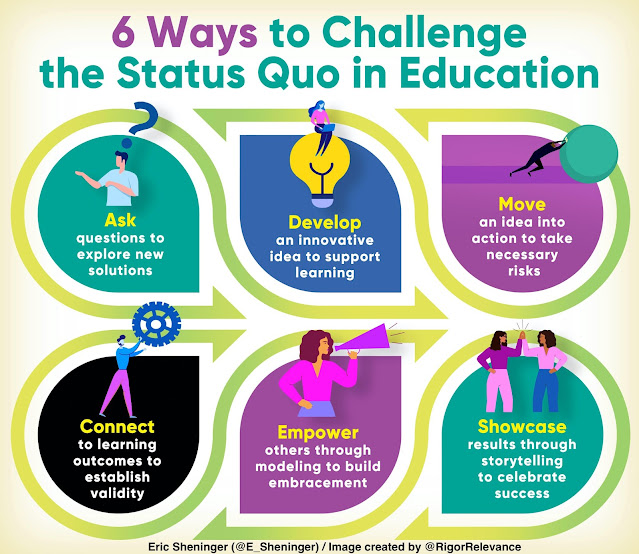It is no secret how we retain information, construct new knowledge, and develop competencies critical for success in the world of work and, more importantly, life. Learning is shaped by specific conditions that are either created or engaged in by chance that allow for authentic application through an immersive experience. If there were a secret sauce, then that is it, but it's not as mysterious as one might think. When it comes to classrooms and schools getting students actively involved, it isn't a gimmick. It is a proven way to improve academic outcomes.
As I wrote in a recent post, direct instruction serves a purpose and can be an invaluable strategy to help set the stage for learning. The key is to not only rely on this teaching technique as it mainly focuses on providing information and modeling as opposed to active learning. Research shows how students learn best, and it's not by talking at them for extended periods. Take a look at this synopsis from Peter Reuell:
For decades, there has been evidence that classroom techniques designed to get students to participate in the learning process produce better educational outcomes at virtually all levels. A Harvard study suggests it may be important to let students know it. The study shows that, though students felt as if they learned more through traditional lectures, they actually learned more when taking part in classrooms that employed so-called active-learning strategies by scoring higher on tests.
There are many ways to make learning stick. Here are things to consider as you develop lessons, activities, and assessments.
- Cognitive overload inhibits learning. Too much information results in stress that prevents students from assimilating information effectively (Waddington, 1996).
- Learning requires an emotional journey. Emotion has a substantial influence on the cognitive processes in humans, including perception, attention, learning, memory, reasoning, and problem-solving. Emotion has a particularly strong influence on attention, significantly modulating the selectivity of attention as well as motivating action and behavior (Tyn et al., 2017).
- Help learners embrace mistakes. By constructing a psychologically safe environment through reframing metacognitive interpretation of subjective difficulty, children can express their full cognitive potential (Autin & Croizet, 2012).
- Create opportunities for students to teach each other. When students actually teach the content of a lesson, they develop a deeper and more persistent understanding of the material than from solely preparing to teach (Fiorella & Mayer, 2013).
- Find ways to include novelty. Extensive research has shown that you have to navigate through unknown territory when visiting a new place and remember landmarks to find your way back. Quickly learning where to expect danger and where to find rewards is therefore crucial for survival. Several theories have suggested that to promote learning, novelty elicits a learning signal by activating dopamine, making it easier to remember.
- Focus on active application. As noted at the beginning of this post, research has shown that students learn more when they are actively involved in the process.
- Promote collaboration and peer interaction. Research in cognitive science has illustrated the efficacy and significance of social learning, leading to improved academic and behavioral outcomes (Li & Jeong, 2020, Wood & O'Malley, 1996).
The ideas above set the stage for incorporating a variety of pedagogical techniques such as scaffolded questions, inquiry-based learning, and performance tasks where reflection, movement, and purposeful play can be integrated. In Chapter 4 of Disruptive Thinking in Our Classrooms, I dive into these practical and realistic strategies and many others that can help learn stick for all kids. When it is all said and done, the key takeaway is more significant levels of empowerment and ownership. Learning is and should be treated as a process, not an event. Hence the need for research-based pedagogies that don't prepare kids for something but anything!
Autin, F. & Croizet, J. C. (2012). Improving working memory efficiency by reframing metacognitive interpretation of task difficulty. Journal of Experimental Psychology: General, 141(4), 610.
Fiorella, L. & Mayer, R. E. (2013). The relative benefits of learning by teaching and teaching expectancy. Contemporary Educational Psychology, 38(4), 281-288.
Li, P. & Jeong, H. (2020). The social brain of language: Grounding second language learning in social interaction. NPJ Science of Learning, 5(1), 1-9.
Tyng, C. M., Amin, H. U., Saad, M., & Malik, A. S. (2017). The Influences of Emotion on Learning and Memory. Frontiers in psychology, 8, 1454. https://doi.org/10.3389/fpsyg.2017.01454
Waddington, P. (1996). Dying for information: an investigation of information overload in the UK and world-wide. London: Reuters Business Information.
Wood, D. & O'Malley, C. (1996). Collaborative learning between peers: An overview. Educational Psychology in Practice, 11(4), 4-9.





